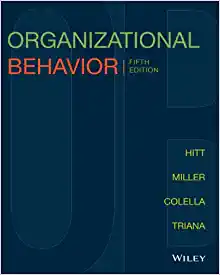Perceiving is believing (as in seeing is believing). It is the strategic leaders ethical responsibility to have
Question:
Perceiving is believing (as in “seeing is believing”). It is the strategic leader’s ethical responsibility to have clear, well-substantiated, modifiable beliefs about organizational behaviors they and others cause. Think of the damage that misunderstandings from misperceptions do each moment of every workday all across the globe. Damage spreads from two people erroneously believing the other is in the wrong all the way through to splitting an entire organization. Perhaps they have not thought of continuously improving the quality of their workplace learning as an ethical obligation. It is so because perceptions form beliefs. Assumptions bloom from beliefs. Rules for framing and making decisions are drawn from assumptions about the matter in question. Actions ensue. Good or bad things happen. Each learner/associate/manager is a responsible or irresponsible source of those bad or good things. Apperception is the process of understanding by which newly observed qualities of an object are related to past experience. Past behaviors are stitched to new behaviors lesson by lesson. Managers build organizational conditions which foster or thwart responsible apperception.
Here is an original exercise entitled “Source Waters,” suggesting for us how to bring this ethical prospect to life.
Questions:
1. A source is a point of origin like a body of water, a spring or lake from which a river originates. One’s accumulated knowledge is like this.
2. Events in the life of an organization flow, as does a river. Most events inside an organization are social in nature. They spring from the body of behavior, emerging from moment to moment interactions of people as they transact the organization’s business. Thus, people acting on their beliefs are points of origin of events that shape the history and future of an organization.
3. A river ecologist takes a sample from the waters of a river that is miles downstream from the source. Traces of those originating waters are to be found commingled with other elements picked along the way.
4. An “OB ecologist” (if there were such a role) takes a sample from the current events of an organization, days down the stream of time from when persons acted to change the relationship of that organization to its environment. Traces of that originating behavior, and the assumptions and beliefs of the source person(s), can be found commingled with those picked up and sustained conversations occurring along the way.
5. Learners in this exercise become OB Ecologists. Their mission is to find traces of originating behaviors in situations (intriguing samples of organizational life). They are looking for signs of observed actions after which things changed (for the better or for the worse). Who was or were most closely associated with those event-precipitating actions?
6. The core question is, “What must they have been thinking at the time?” Underlying this is the question, “What must they have perceived that made them believe this was the right line of thought and course of action?” Retrospectively, was there sufficiently clear and substantiated understanding for anticipating the downstream, organizational consequences of actions?
7. These OB samples may be taken from nearly any body of evidence that is handy to the class. The best ones are recent, occurring within the learners’ direct experience, and where those who were acting as “source waters” in the situations may be found and interviewed.
8. A suggested experiential learning assignment is that each learner will identify a situation close at hand, in their school, work, or home life, where they may reach and talk with those there at the onset.
9. This is not to place blame, if the situation chosen is problematic, or give credit, if the situation is unusually positive. They are to explore the quality of perceptions at that time. Was there sufficient information? Was there enough time to think through what was occurring and what might follow? Was there undue fear of punishment?
10. Alternatively, learners may use their imaginations to figure out who were sources of events in the news or in cases readily available in this text or from the instructor’s case files. One such readily available case is, “It’s Just a Matter of Timing,” the Strategic OB Moment at the end of this chapter.
11. Learners may bring written or oral reports of their findings to their classmates to compare, contrast, and discuss for ethical implications.
Step by Step Answer:






